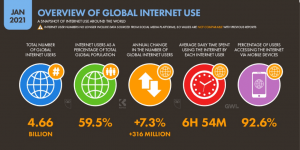
We analyzed the We Are Social and Hootsuite report “Global Digital 2021”, and noticed some interesting facts:
- In 2021 the audience of the Internet in cities with a population of millions almost stopped increasing. But it continues to grow in towns and villages with a population of fewer than 500 thousand people.
- The average daily time spent on the Internet using mobile — 3.39 hours — vs. PC — 3.16 hours.
So, clearly wired Internet is still important for users compared to mobile. Also, we can tell for sure that the development of the Internet access market is moving from metropolitan areas to small towns. Of course not without exceptions.

The ISP market
There is a tendency in large cities for small regional providers to be squeezed out by major ones. Often this happens by purchase with preservation of equipment and customer base and providing of services under one popular brand.
For small and medium independent providers, it becomes more and more difficult to compete, that’s why there are fewer of them left. However, a new niche has appeared: large-scale projects of neighborhood development, integrated development of territories, and the private suburban sector. They can be compared to a small town, whose residents have a very high need for Internet but none of the providers covers it.
This means that the development of the Internet access market will soon get another round, which will be associated with the emergence of new providers, who will improve the quality of services and a more flexible pricing policy due to competition.
Becoming an ISP is not an easy task, that requires large capital investments and several mandatory legal aspects. In this article, we’ll talk about the five main steps on the way to set up that business.
1. Choice of connection method for subscribers and provided services type
First of all, it is necessary to determine the way of connecting subscribers to the Internet and the types of provided services. After that, it is reasonable to choose equipment and premises, the necessary licenses, and permits.
Probably the most popular up to points of distribution to subscribers is a fiber-optic channel. It is more expensive than copper but has significant advantages: virtually unlimited length, minimal delays, packet losses, information security, high bandwidth, low weight cable.
The last mile to the subscriber can be organized in three main ways:
- Copper cable (Ethernet) from the provider’s equipment to the subscriber — the most popular method of switching, low cost and easy to install.
- Fiber optics from the provider’s equipment to the subscriber (FTTB) — the most reliable but also the most expensive way. For connection you can use Ethernet technology (a separate optical port on the provider’s equipment) or xPON technology (multiple subscribers on a single optical fiber).
- Wi-Fi-access to the subscriber — a solution that does not require the installation of wires in the apartment of the subscriber. At the same time, it is not very reliable and fast.
The next step is the choice of provided services. Apart from the access to the network itself, such additional services as digital television (IPTV), telephony (VOIP), file and game servers, virus and network attack protection are becoming more and more popular. They increase the operator’s attractiveness to the subscriber by providing one entry point to all digital entertainment services. But it imposes additional responsibility for the quality of their provision.
2. Search for the premise, network design, purchase of equipment, and incoming channel rent
Access equipment is usually located in the attics or basements of residential buildings. Often it requires the permission of the customer to use the common areas and coordination with the building’s management company.
For the network core and server equipment, you will need a separate room. It should be equipped with a fire alarm system, security system, air conditioning, grounding, and an uninterruptible power supply. Preferably to organize in it a working place of administrator and make a 24-hour access for solving emergency situations.
The rental price depends on location and it is also necessary to take into account the cost of repair and premises preparation.

The choice of equipment depends on the starting load, the services provided, the need for service support, and the response time of the manufacturer or dealer for recovery in the case of a breakdown.
The minimum set of any provider includes:
- passive network equipment (cabinets, racks, shelves, crossovers, tools, patch cords, etc.)
- web servers, mail servers, identity and terminal servers
- server for developers, control and news server
- server for billing and user registration
- active network equipment (routers, switches)
- office equipment
- administrative panel
- data storage equipment
- DPI traffic analysis system (optional)
- uninterruptible power supplies
- SPTA
Preparation of a business plan and project, which will describe and calculate all components of the project in detail, will help to avoid unnecessary costs for expensive equipment. On average, the cost of equipment is from 60 to 100 thousand dollars.
In order to provide Internet access, you must get an uplink from an upstream provider via a peer-to-peer agreement. Ideally, there should be more than one connection (up to 5) to provide fault tolerance in case one of them fails.
The monthly cost of 1 Gbit/sec can be up to 4000 dollars. It is reasonable to use deep traffic analysis (DPI) systems, as they require a one-time capital investment, but can be recouped in just six months of use.
3. Legal registration and licensing
Legal processing consists of:
- getting the status of a legal entity
- registering as a Limited Liability Company (LLC)
- opening a bank account
You will need copies of constituent documents, state registration documents, and tax registration certificates for the bank account.
Since an ISP is a communications service provider, its work needs to be licensed. In case if apart from Internet access there are provided no other services, usually at least two licenses are required:
- A license for telematic services
- License for data transferring except for data transfer for voice information.
Each additional service (IP telephony, hosting, data backup, digital television) also requires licensing and additional time and financial expenses.

4. Staff recruitment and work organization
To implement an Internet access-providing project there you will need a qualified team. You can outsource accounting, human resources, the laying of cables, the installation of equipment, etc. But for providers, it’s a must to have their own operating communication lines service, network engineers, administrators, technical support operators, managers, and marketing specialists.
The entire staff will number from 10 to 15 people. Of course, you should take into account the payroll, insurance, and pension contributions.
The work organization should consider all the details of the business, and most importantly — focus on providing high-quality services. Slow Internet, periodic connection interruptions, payment difficulties, inconvenient rate plans, bad technical support — all these factors will adversely affect the credibility of your company and force subscribers to go to a competitor.
That is why the team must have not only good IT specialists but also experienced managers who can organize the maximum efficient work process.
5. Project commissioning and promotion
To put a project into operation and obtain ISP status is not enough simply to lay cables and install equipment. You have to create a communication node project and submit it for expert review. Successful examination passing depends on the project itself and on the technical equipment.
Only after a successful expert evaluation facility can be put into operation. The communication node’s design time can take from two weeks to three months, and expert evaluation of the project from a month to a year.
Steps for taking a communication node into operation:
- Information transmission on the beginning of construction of a communication facility to regulatory organizations.
- Preparation of documents in accordance with your country’s regulations.
- Notification of regulatory organizations of the construction completion and application for the commission passing.
- Review of documents by a designated inspector, an inspection of AP and TM nodes.
- Obtaining permission for operation.
The estimated cost of commissioning will be about 2000 dollars.

The profitability of providing Internet access in general is above 60%. But competition and the need for strict quality control make the process of continuous development very important. A successful provider must increase the speed, expand the list of services, upgrade the equipment and develop internal services — this is the only way for the business to be profitable.
The marketing department is responsible for the provider’s awareness among the target audience, searching for new areas for connection, holding promotions, and creating a stable brand and credibility of the company.
Providing Internet access is a business that requires a careful and responsible approach to all stages, from planning to commissioning. The market for ISP is far from being saturated, and the emergence of new urban areas stimulates even more of its development. Following the five basic steps described above will help you not only to take your place next to the major service providers of your country but also to compete with them.